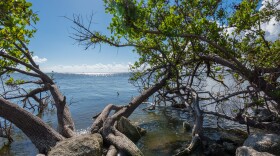A judge’s order issued this week confirms a new lawsuit against the Florida Department of Environmental Protection is valid and can move forward, according to the Florida Springs Council, the nonprofit which filed the lawsuit in Hernando County earlier this month.
FSC seeks a court order forcing FDEP to adopt new rules for issuing permits to pump Florida’s freshwater springs, also known as consumptive use permits, or CUPs. A 2016 state law requires the agency to do just that, but nearly nine years later, the new rules still haven’t come to fruition.
Now, after trying time and time again to engage with FDEP on the outstanding rules — and repeatedly getting the runaround — FSC is left with little recourse beyond the lawsuit filed earlier this month, according to an attorney representing the nonprofit.
“We’re not messing around anymore,” said Rachael Curran, Staff Attorney at Stetson University’s Jacobs Public Interest Law Clinic for Democracy and the Environment.
RELATED: Dozens rally in support of Florida freshwater springs
Most Floridians’ drinking water comes from the same groundwater feeding Florida’s 1,000+ freshwater springs. But for 30 designated Outstanding Florida Springs, “action is urgently needed” to prevent future water quality and quantity declines, according to the 2016 Florida Springs and Aquifer Protection Act.
For those 30 Outstanding Florida Springs, the law directs FDEP to adopt “uniform rules for issuing permits which prevent groundwater withdrawals that are harmful to the water resources.” Additionally, FDEP must define what the clause “harmful to the water resources” actually means.
“It was a recognition that the rules weren't working that led the Legislature to say we need better rules, we need more protective rules,” said Florida Springs Council Executive Director Ryan Smart.

Over pumping springs to the point of exhausting Florida’s water supply by sheer volume is one concern in itself. But another is water quality, which can be compromised by low spring flow. Less water flowing through a spring system at slower rates allows for higher, more harmful pollutant concentrations to form.
Florida’s springs protection law also addresses water quality — and FDEP is falling short on those requirements, too, according to an appellate court’s ruling last year on a different lawsuit FSC previously filed against the state agency.
That complaint focused on the Basin Management Action Plans, or BMAPs, required for the 24 of 30 total Outstanding Florida Springs that are heavily polluted. The 2016 law requires FDEP to develop BMAPs to help restore those 24 impaired springs to better health, but FSC successfully argued those BMAPs weren’t designed to actually work.
“DEP argued that the BMAPs did not need to actually achieve water quality goals, only have a ‘target’ for doing so,” according to FSC. Now, FDEP is in the process of updating all its BMAPs by July 1, 2025.
FDEP does not comment on pending litigation, according to an email from an agency spokesperson responding to a request for comment Wednesday.
Meanwhile, per- and polyfluoroalkyl substances (PFAS) are infiltrating Florida’s freshwater springs, according to new University of Florida research. Of the 50 springs analyzed in that study, statewide, the three most contaminated springs were all within a 10-mile radius in Deltona: Green, Blue and Gemini Springs, in that order (from highest to lowest concentration of PFAs).

State data indicates a projected water shortage could begin as soon as next year. That means it is critically necessary for Florida to adopt a longer-term, more consistent and accountable planning process for water quality and supply projects, according to a government watchdog group.
Right now, Florida’s way of approving such projects is largely “catch-as-can,” according to Florida TaxWatch President and CEO Dominic M. Calabro.
Meanwhile, nearly nine years after lawmakers passed the 2016 law, Florida's spring systems are suffering from FDEP’s failure to act, Smart said Wednesday.
“In the time since this law was passed, [when] these rules should have been adopted, hundreds of consumptive use permits, which harm the springs, have been issued,” Smart said. “We have a permitting system for a reason. The idea was never that everybody gets as much water as they want.”

FDEP recently held a workshop to gather public input on draft rules the agency developed for issuing CUPs. But as long as the rules stay in draft form, very little can be done with them: keeping FSC in a “holding pattern,” per Curran.
“We still don't even have a proposed rule; we only have these draft rules, which left in draft form are meaningless and unchallengeable,” Curran said. “Draft rules aren't challengeable … Only proposed rules are.”
The state agency will have twenty days to respond to FSC’s complaint, per FSC.





